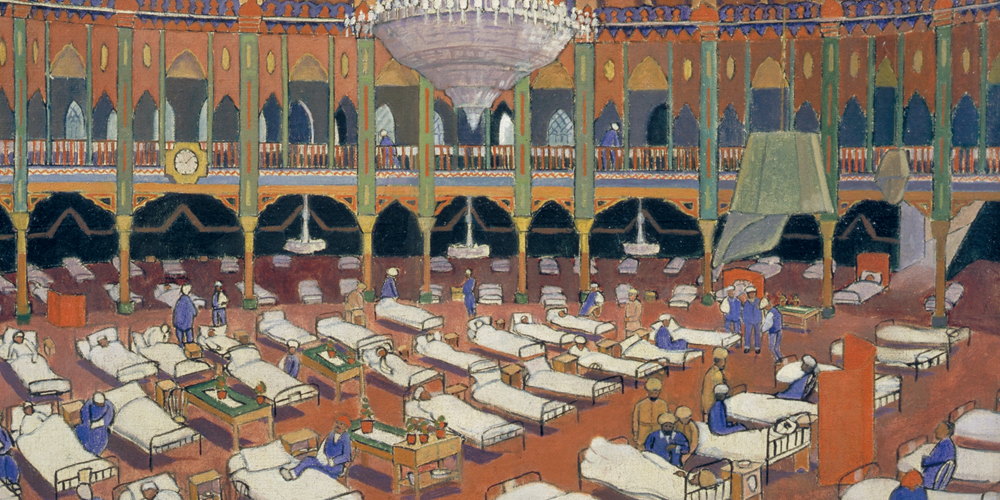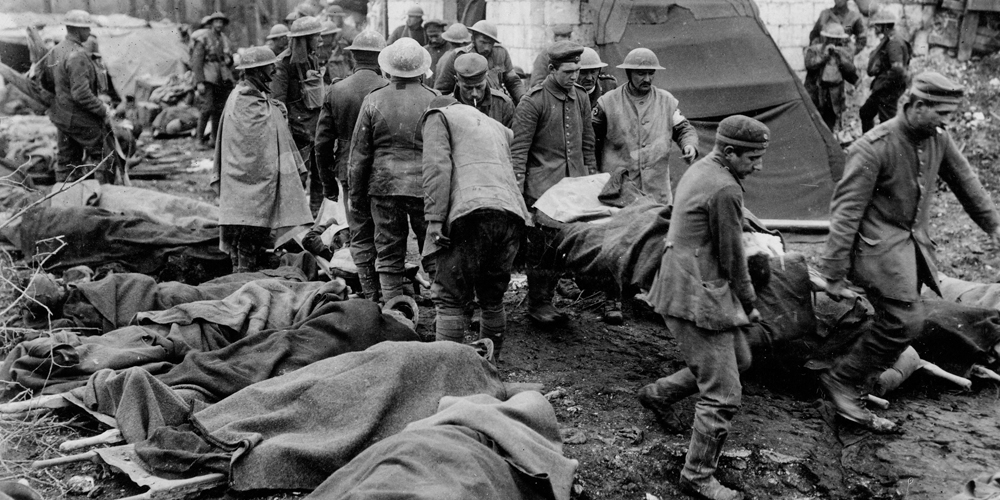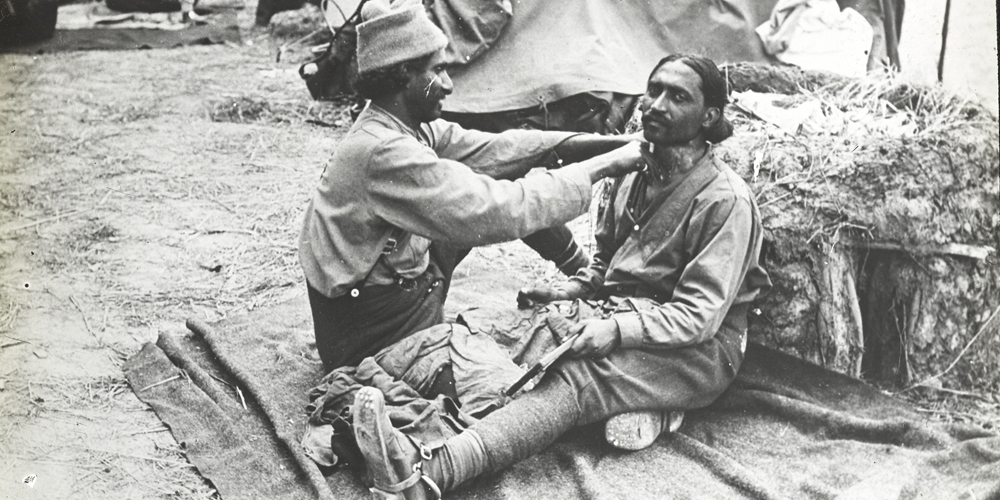
The Royal Army Medical Corps
The Royal Army Medical Corps looked after the health of the Army and its soldiers. Some of the medical care was pre-emptive. Large numbers of men living outdoors in the close, cramped confines of unhygienic trenches with rats and lice got sick or infected, so a medical officers’ job was partly to ensure soldiers kept clean and looked after their feet. The RAMC also advised on the introduction of steel helmets and different kinds of gas mask.
The RAMC also organised the evacuation and treatment of troops wounded in battle. Soldiers passed through a chain of regimental aid posts, dressing stations and casualty clearing stations where they would either be treated and sent back into active service, or, where necessary, hospitalised. The biggest hospitals for the most serious cases were back in the UK, and soldiers fantasised about getting a ‘Blighty wound’, a wound serious enough to get them sent back to Blighty (Britain), but with no long term consequences.
An Advanced Dressing Station. On the right of the picture German prisoners of war have been enrolled as stretcher bearers.
Army doctors were very familiar with injuries caused by bullets and bayonets, but new technologies generated new kinds of casualty. High explosive shells caused massive trauma that often resulted in amputation; poisonous gas blinded, burned or choked those affected.
Injuries
Trench Foot
Trench foot was caused by feet being constantly wet and cold: the trenches were often full of water and mud, and soldiers had constantly wet feet with no real opportunity to dry them out. The only way to prevent it was for a soldier to take off his boots and socks each day and completely dry his feet.
Trench foot is a very unpleasant disease that affected a lot of soldiers. Initial symptoms were feet becoming numb, then turning red and blue and starting to swell. As the disease worsened, feet started to get blisters and open wounds, which led to infection, and feet started rotting and smelling horrible. If it was not treated, patients often ended up with gangrene, which could mean that feet had to be amputated.
Officers began doing regular foot inspections, and soldiers were put into pairs and made responsible for each others’ feet which was a way of forcing them to take off their boots and socks. Another preventative treatment was to apply an unpleasant smelling whale oil to feet to help prevent trench foot.
Images can be found online, but are often rather gory.
Shellshock
The most mysterious injuries, at least at the start of the war, were mental. What today is widely understood as post-traumatic stress disorder or combat stress was poorly understood. ‘Shellshock’, as it was popularly known, could leave a soldier confused and disoriented, or rob him entirely of physical control of his body.
One of the results of shellshock was that soldiers couldn’t cope with the continuous sound of shells dropping and being in the trenches, and some of them deserted. The Army was very harsh on those who did, making an example of them to deter others from doing the same, and often parading them in front of the troops. Many were arrested, court-martialled and executed at dawn. A firing squad, one of whom would have a blank round in his rifle, would face a man with blindfold on and a white target over his heart and all would shoot together. In total, 306 men from the British and Commonwealth military were executed. Almost 90 years later, on 8 November 2006, the soldiers who were executed for desertion and other offences during the First World War were pardoned. Des Browne, the incumbent Defence Secretary, said, “This is not about rewriting history. I do not want to second guess decisions made by the commanders at the time. I believe it is better to acknowledge that injustices were clearly done in some cases, even if we cannot say which, and to acknowledge that all these men were victims of war.”
The Indian Army Hospital at Brighton Pavilion
Approximately 4,000 Indian Army troops and Gurkhas who were wounded were sent to recover at The Pavilion in Brighton, which was turned into a military hospital for Indian Soldiers. This and similar hospitals became affectionately known as Dr Blighty.
Careful provision was made to ensure that the Hospital met everyone’s religious and dietary needs. Water from the well in the gardens was plumbed into separate neatly labelled Hindu and Muslim taps in every room. Similarly labelled milk churns and jugs were lined up in nine newly built field kitchens. Instead of squatting comfortably on the ground, the regimental cooks and orderlies had to be trained how to cook standing up at what must have appeared to be a bizarre western stove! In the town, a butcher had set up a halal slaughterhouse and supplied wagon-loads of goats for the Muslim convalescents. New bathrooms – also segregated – were in place, with squat lavatories instead of western-style ones.
Burial rights were also observed according to the respective religions of the fallen. Traditionally, Sikhs and Hindus (including Gurkhas) cremate their dead and scatter their ashes in flowing waters. Muslims buried their dead. This practice was followed for the 53 Sikh and Hindu soldiers who died in Brighton hospitals during the War. Each was given an open-air cremation at a specially built funeral platform on the South Downs overlooking Brighton.
The wounded and sick Indian soldiers in Brighton and other hospitals located near the south coast of England played cards and participated in exercise classes to help them recover. A great deal of letter-writing was also undertaken by convalescing soldiers. Postcards and photographs from the era show them taking trips to the beach and sight-seeing, often in cars and on buses. These activities were closely supervised by British military authorities.
British military authorities were careful not to let white women nurses treat Indians. Unlike in France, where records show that female nurses treated Indian soldiers, in England they were treated by male doctors and male nurses (with a few civilian exceptions). This was mainly due to the fear of sexual liaisons taking place that were seen as harmful to the reputation of white women. As their letters suggest, though complimentary about the care they received, soldiers were critical of the restrictions placed on their movement. Chaperoned at every occasion, with every outing carefully stage-managed, many felt like prisoners.

Brighton Dome – This painting by Douglas Fox-Pitt depicts the Indian Army Wounded in the dome of Brighton Pavilion, which was converted into a hospital
© IWM Art 323
DEISGN AND TECHNOLOGY ACTIVITY 5


